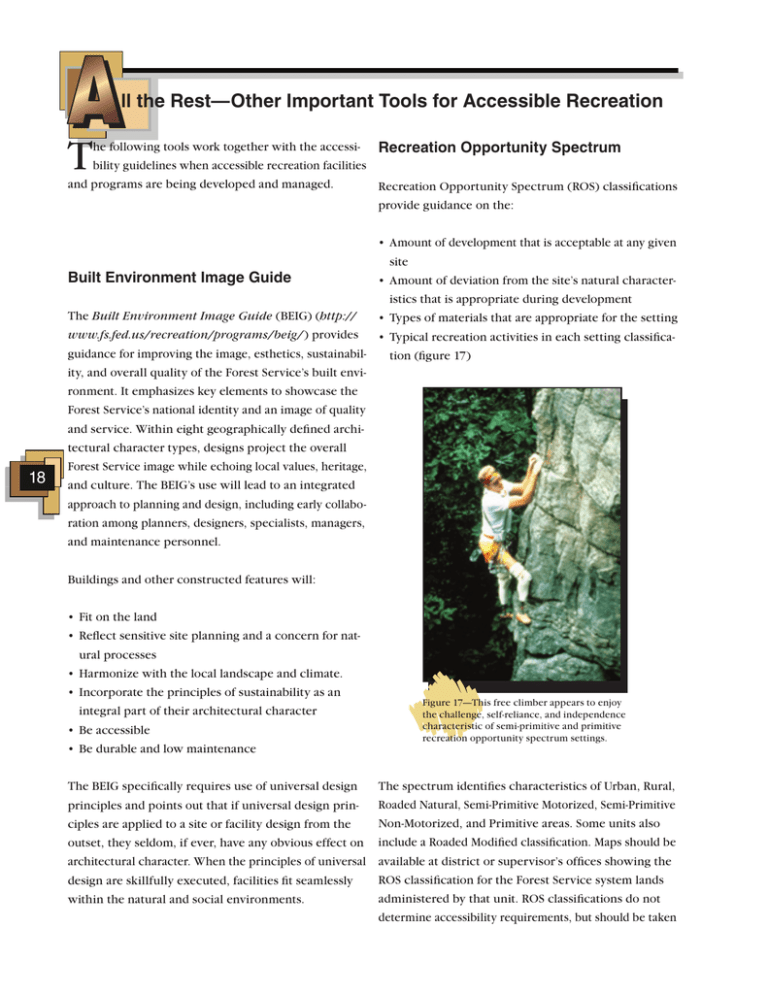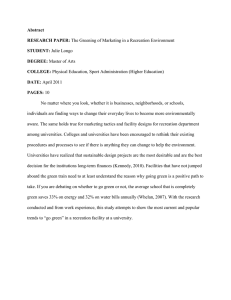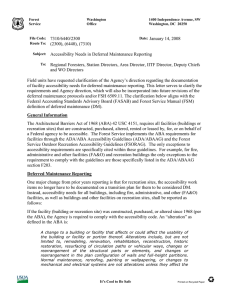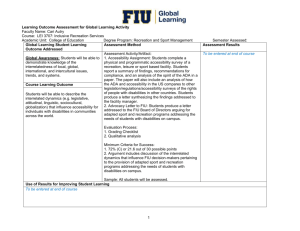T ll the Rest—Other Important Tools for Accessible Recreation Recreation Opportunity Spectrum
advertisement

ll the Rest­—Other Important Tools for Accessible Recreation T he following tools work together with the accessi- Recreation Opportunity Spectrum bility guidelines when accessible recreation facilities and programs are being developed and managed. Recreation Opportunity Spectrum (ROS) classifications provide guidance on the: 18 • Amount of development that is acceptable at any given site Built Environment Image Guide • Amount of deviation from the site’s natural characteristics that is appropriate during development The Built Environment Image Guide (BEIG) (http:// • Types of materials that are appropriate for the setting www.fs.fed.us/recreation/programs/beig/) provides • Typical recreation activities in each setting classificaguidance for improving the image, esthetics, sustainabiltion (figure 17) ity, and overall quality of the Forest Service’s built environment. It emphasizes key elements to showcase the Forest Service’s national identity and an image of quality and service. Within eight geographically defined architectural character types, designs project the overall Forest Service image while echoing local values, heritage, and culture. The BEIG’s use will lead to an integrated approach to planning and design, including early collaboration among planners, designers, specialists, managers, and maintenance personnel. Buildings and other constructed features will: • Fit on the land • Reflect sensitive site planning and a concern for natural processes • Harmonize with the local landscape and climate. • Incorporate the principles of sustainability as an integral part of their architectural character • Be accessible • Be durable and low maintenance The BEIG specifically requires use of universal design principles and points out that if universal design principles are applied to a site or facility design from the outset, they seldom, if ever, have any obvious effect on architectural character. When the principles of universal design are skillfully executed, facilities fit seamlessly within the natural and social environments. Figure 17—This free climber appears to enjoy the challenge, self-reliance, and independence characteristic of semi-primitive and primitive recreation opportunity spectrum settings. The spectrum identifies characteristics of Urban, Rural, Roaded Natural, Semi-Primitive Motorized, Semi-Primitive Non-Motorized, and Primitive areas. Some units also include a Roaded Modified classification. Maps should be available at district or supervisor’s offices showing the ROS classification for the Forest Service system lands administered by that unit. ROS classifications do not determine accessibility requirements, but should be taken All the Rest­—Other Important Tools for Accessible Recreation protect/steward/sanman.html) is a cooperative project into account when designing site improvements. For instance, improvements in primitive and semi-primitive of the Green Mountain Club and the Appalachian Trail settings may sometimes be needed for resource protec- Conference. “Resolving problems of backcountry sanitation tion. In roaded natural, rural, and urban settings, imis a continuous challenge for trail clubs and provements commonly are provided for visitor comfort land managers. This manual was created in and convenience. More information about the ROS is the belief that all remote recreation areas will available to Forest Service and Bureau of Land Managebenefit from an expanded discussion of backment employeees at: http://fsweb.wo.fs.fed.us/eng/ country sanitation.”—Pete Antos-Ketcham,Education facilities/recopp.htm. Coordinator/Facilities Manager, Green Mountain Club Wilderness Access Decision Tool Accessibility Guidebook for Outfitters/ Details and implementation guidance for applying Title Guides Operating on Public Lands V Section 507c, the one section of the Americans with Disabilities Act that applies to Federal agencies and to the programs and facilities on federally managed lands can be found at: http://carhart.wilderness.net/docs/ wild_access_decision_tool.pdf. This decision matrix is designed to assist Federal managers of wilderness areas in making appropriate, objective, and consistent decisions meeting the legal requirement to provide equal opportunity for all individuals, while ensuring there will be no fundamental change to the wilderness experience for all individuals, in accordance with the 1964 Wilderness Act. This guidebook provides a framework to help outfitters and guides who operate under a special-use permit from the Forest Service better serve all visitors (figure 18). The guidebook addresses basic facility accessibility Appalachian Trail Conservancy’s Backcountry Sanitation Manual This comprehensive manual explains the basic issues of remote area sanitation, including health, esthetics, and regulations, but it focuses on the construction and maintenance of moldering and composting toilets, and includes a case study and design plans. The Backcountry Sanitation Manual (http://www.appalachiantrail.org/ Figure 18—Outfitters and guides provide the logistics and support for visitors to enjoy a wide range of opportunities on National Forests, including fishing. 19 All the Rest­—Other Important Tools for Accessible Recreation issues, but focuses primarily on program and activity accessibility. Outfitters and guides who operate businesses on public lands are governed by the ADA because they are providing public accommodations and are also governed by Section 504 of the Rehabilitation Act because they are operating under special-use permits from Federal agencies. The guidebook identifies legal requirements and provides guidelines, suggestions, and practical tips for complying with both the ADA and Section 504 of the Rehabilitation Act while providing high-quality services. The guidebook is available at: http://www.fs. fed.us/recreation/programs/accessibility/. 20 Accessibility Guidebook for Ski Areas Operating on Public Lands guidebook provides the legal mandates, suggestions, and practical tips for complying with laws and regulations, while providing high-quality services. The guidebook is available at: http://www.fs.fed.us/recreation/programs/ accessibility/. Cooperative Publications The Federal Highway Administration is cooperating with the Forest Service to provide Forest Service publications and videos to the public. Many publications are available at: http://www.fhwa.dot.gov/environment/fspubs/ index.htm in HTML and PDF (Acrobat) formats. Paper copies can be ordered at: http://www.fhwa.dot.gov/ environment/rectrails/trailpub.htm. This guidebook provides a framework to help ski areas operating under special-use permits from the Forest Service better serve all visitors (figure 19). The guidebook addresses facility and program accessibility. Ski Standard Forest Service National Trail areas located on public lands are governed by the ADA Specifications because they are providing public accommodations and also are governed by Section 504 of the Rehabilitation Engineering Management Publication EM–7720–103, Act and related regulations, because they are operating Standard Specifications for Construction and Mainteunder special-use permits from a Federal agency. The nance of Trails, provides a uniform set of specifications for contracted trail work throughout the Forest Service. Although these specifications do not address accessibility, they can be used in conjunction with the FSTAG. The publication is available at: http://www.fs.fed.us/ database/acad/dev/trails/trails.htm. Trail Construction and Maintenance Notebook Figure 19—Ski areas that operate on public land must provide equal opportunity to their services. The Missoula Technology and Development Center’s Trail Construction and Maintenance Notebook contains All the Rest­—Other Important Tools for Accessible Recreation basic trail construction and maintenance information, Equestrian Design Guidelines for Trails, presented in an easy-to-understand fashion. It is available Trailheads, and Campgrounds at: http://www.fhwa.dot.gov/environment/fspubs/ 00232839/ and at: http://www.fs.fed.us/eng/pubs/ A new guidebook for equestrian facility design is schedhtmlpubs/htm04232825/. uled for completion in 2006. This comprehensive technical resource guide will detail those elements of planning, Although this publication doesn’t address accessibility, design, and construction that are specific to equestrian it is an important tool used during trail construction and trails, trailheads, and campgrounds. planning. It can be used in conjunction with the FSTAG. A new version of the Trail Construction and Maintenance Notebook will be printed during 2006. The Facilities Toolbox The Facilities Toolbox is an interactive, internal Forest Service facility management Web site designed to help Sidewalks and Trails line officers and their staffs manage facilities effectively. The toolbox focuses on issues at administrative sites, but The Federal Highway Administration has published also contains topics such as Accessibility, Partnerships, Designing Sidewalks and Trails for Access, a two-part Recreation Fee Program, Historic Facilities, and Water report on pedestrian accessibility: and Wastewater. Forest Service and Bureau of Land Management employees can access this Web site on their Part 1: Review of Existing Guidelines and Practices is internal computer networks at:http://fsweb.mtdc.wo.fs. available in both HTML and PDF formats at: http://www. fed.us/toolbox/. fhwa.dot.gov/environment/sidewalks/index.htm. Part 1 lays out the history and practices of applying accessibility concepts to sidewalks and pedestrian trails. Part 2: Best Practices Design Guide is available in both HTML and PDF formats at: http://www.fhwa.dot.gov/ environment/sidewalk2/index.htm. Part 2 provides recommendations on how to design sidewalks, street crossings, intersections, shared-use paths, and recreational pedestrian trails. Infra Infra (http://infra.wo.fs.fed.us/infra/) is the Forest Service corporate integrated data management tool developed for the purposes of inventory, asset management, and upward reporting of information concerning constructed features, including their associated financial data. Infra contains data on the accessibility status of constructed features and data on annual and deferred maintenance costs associated with accessibility requirements. The recreation site data entry forms have fields to enter information concerning the status of accessibility under the site costs tab and also under the features tab. These data must be updated annually. 21 All the Rest­—Other Important Tools for Accessible Recreation Recreation & Heritage Resources Integrated Business Systems 22 Deferred Maintenance Accessibility requirements must be met just as other The Meaningful Measures recreation resources manage- building codes must be met. The costs for any needed ment system has recently become the Recreation & accessibility improvements should be included in the Heritage Resources Integrated Business Systems (http:// Infra deferred maintenance figure. These costs are www.fs.fed.us/r3/measures/). This recreation resources categorized as deferred maintenance because the work management system identifies customer standards the already should have been completed to comply with the Forest Service expects to provide across all recreation ABA. and heritage resources program areas. Standards form the baseline for estimating the total cost for quality visitor How and when the costs are included in the deferred opportunities and services. Compliance with the acces- maintenance figure depends on the transition plan for sibility guidelines (figure 20) is an important quality that facility. If transition plans have not been completed, measure within the national standards for recreation the cost to complete them is included in the deferred sites under the responsiveness key measure. The Infra maintenance figure because they were due for completion database houses recreation information including inbefore the current fiscal year. The transition plan process ventory, operation and maintenance costs, recreation(per 7 CFR 15e, section 150) is as follows: use data, and information on accessibility. The database is used to implement the Recreation & Heritage • Evaluate the facility. Resources Integrated Business Systems. • Record improvements needed to meet accessibility standards. • Develop the transition plan, including: —Items to be improved —When the improvements are scheduled if the improvements will take more than 1 year to complete Figure 20—The perfect photo spot—a spectacular view and the right mix of resource protection, site development, and accessibility. When the transition plan is completed and approved, the costs to implement accessibility code improvements are included in the deferred maintenance figure. If the transition plan will take more than 1 year to complete, costs for actions scheduled for the current year are included in the deferred maintenance figure. Costs for actions that are past due also are included in the deferred maintenance figure. Costs for actions scheduled for future years aren’t added to the current year’s deferred maintenance figure. They are added to the deferred maintenance figure in the year they are scheduled for completion. As work is completed, it should be shown as an accomplishment in Infra for that fiscal year. All the Rest­—Other Important Tools for Accessible Recreation Construction and Maintenance Practices Even the best universal design can be ruined, often unintentionally, by construction or maintenance practices that change accessible design features into barriers. Construction engineering and inspection personnel must have a thorough understanding of the design intent and of accessibility issues or they must check with the designer before allowing any deviations from the design. For example, field changes such as increasing the slope on a walkway to reduce the cost of asphalt paving or increasing the drop at an exterior door threshold to reduce issues with driving rain can make the entire project inaccessible. CONSTRUCTION TIP— Avoiding unintended consequences Consider accessibility when construction is in progress. Any change order intended to solve one problem could create another. For example, standard speed humps can slow speeding traffic in a campground, but they can also become barriers if the main pedestrian access route through the campground is the roadway. Speed humps can be staggered to block only one lane at a time or limited to the center of the road, leaving 32 inches (815 millimeters) of clear passage at each side. Both of these approaches will slow traffic without blocking access. Maintenance and operations activities can help or hinder accessibility. When maintenance personnel are being trained, include information on accessibility. When employees understand how their work can affect accessibility, they can look for ways to improve accessibility. For example, a chair or garbage receptacle beside the door of an accessible restroom stall will render the stall inaccessible if it prevents the door from opening fully. Picnic tables that are fastened to the floor of a picnic shelter to prevent theft but that aren’t spaced far enough apart will be impossible for some people to use. When gravel walkway material is allowed to erode away from the entrance of a campground restroom, the restroom soon will become inaccessible. Maintenance also can be an opportunity to improve accessibility. Over time, a series of small changes can make a big difference. MAINTENANCE TIP— Improving accessibility through maintenance Improved accessibility doesn’t always mean new construction or major renovation. Maintenance and routine service present many opportunities to improve accessibility. An accessible surface is firm and stable. Use caution with the size and depth of gravel when maintaining unpaved surfaces. Generally, smaller gravel with some fine material can be compacted to a firmer surface than larger gravel or gravel that is all the same size. Depending on the surfacing material, mixing in some soil stabilizer might provide an accessible, natural-appearing surface. Practical Approach—The surface is probably firm and stable if ruts are not left by: • Someone riding a bicycle with narrow tires • Someone pushing a 3-year-old in a folding stroller with small plastic wheels On paved parking lots, designating the required accessible spaces is relatively easy when repainting the parking lot stripes, especially right after the lot Continued 23 All the Rest­—Other Important Tools for Accessible Recreation has been seal-coated. Designating accessible parking spaces on gravel lots is even easier. All you need is a sign and probably some parking bumpers to generally define the width of an accessible parking space without obstructing the access aisle. Ensure that signs and curb cuts for ramps are located appropriately— next to, not in the parking space or access aisle. Building entries must be within ¼ inch (6.4 millimeters) of being flush with the grade of the outside access route and have a beveled doorsill that isn’t more than ½ inch (13 millimeters) high. Sometimes it’s fairly easy to add surfacing material, shim up the deck or porch boards, or use asphalt or concrete to bring the access route up to the building floor. 24 or gravel surface can’t be made firm and stable. If you don’t have funding for a major site renovation, you can repair the area around a few hydrants at a time. When operating controls need replacing, think about accessibility. To comply with accessibility guidelines, all controls must be operable without pinching, grasping, or twisting the wrist and with no more than 5 pounds (2.2 newtons) of pressure. When accessible parts are ordered, consider ordering extra parts to keep on hand for future replacements. Practical Approach—If you can operate the control with a closed fist and with less than 5 pounds (2.2 newtons) of pressure, the control is accessible. Three ways to provide accessible controls are shown in figures 21, 22, and 23. The surface at the base of water hydrants at recreation areas must be firm and stable with a 60-inch (1,525-millimeter) turning radius. Consider building a wood or concrete surface around hydrants if a soil Figure21. Figure22. Figure23. Figures 21, 22, and 23—Examples of accessible operating controls. esigning Access Into the Outdoor Environment T his chapter explains how to incorporate the Forest Construction is building a new trail, recreation site, or Service Outdoor Recreation Accessibility Guidelines facility where there was none before. (FSORAG) and Forest Service Trail Accessibility Guidelines (FSTAG) into the outdoor recreation environment. An alteration of a trail is a change in the original purpose, intent, or function for which the trail was Suppose you are assigned a project to reconstruct a picnic designed. area or campground, or to design a trail. Based on information from the previous chapters, you know that you’ll An alteration of a recreation site, building, or fabe using FSORAG and FSTAG rather than Architectural cility is a change to a portion of a recreation site, Barriers Act Accessibility Standards (ABAAS). As you building, or facility that is addressed by the accessibilread through the FSORAG and FSTAG, however, you may ity guidelines and that affects the usability of the site, have questions about how to apply all the conditions for building, or facility. departure, provisions, and exceptions to the provisions of the guidelines. The purpose of this chapter is to Maintenance is routine or periodic repair of existing explain how designers should apply the guidelines and trails, recreation sites, or facilities. Maintenance doesn’t to help them understand the rationale behind each of change the original purpose, intent, or function of a the provisions. facility. Maintenance work isn’t covered by the FSORAG or FSTAG. Maintenance includes but isn’t limited to: • Repairing or replacing deteriorated, damaged, or vandalized trails, facilities, or components. Examples Terminology include repainting, removing graffiti, and repairing or replacing components of facilities with new comSome terms used in the FSTAG and FSORAG may not be ponents similar to the original ones. Components familiar. The terms include: include sections of bridges or boardwalks, signs, fencing and railings, siding, windows, and roofing. Conditions for departure from the guidelines are • Removing debris and vegetation, such as fallen trees circumstances found in natural environments that may or broken branches; clearing encroaching vegetation make compliance with the provisions difficult. from trails, pathways, lawns, or landscaped areas; and removing rock slides. Exceptions to the provisions are allowed under certain • Maintaining trail tread and access routes, including circumstances and are identified in paragraphs labeled filling ruts, reshaping a trail bed, replacing or reshaping “Exception” in the FSTAG and FSORAG. surfacing material, repairing washouts, installing riprap to retain cut and fill slopes, constructing retaining Scoping means figuring out when, how much, and walls or cribbing to support trail tread, and repairing where the guidelines apply. concrete or asphalt paving. • Performing erosion control and drainage work, such Technical provisions state what is required to be done. as replacing or installing drainage dips or culverts and realigning sections of trail to reduce erosion or avoid The following terms describe construction and mainteboggy areas. nance work: 25 Designing Access Into the Outdoor Environment 26 While the FSORAG and FSTAG don’t apply to mainte• Accessibility is to be considered up front, not as an nance, Forest Service policy is to improve accessibility afterthought. wherever the opportunity arises. Where practicable and feasible, resource managers are encouraged to improve • All new construction and alterations will be as accesaccessibility through maintenance and repair activities sible as possible. as explained in maintenance tip Improving accessibility through maintenance. • Compliance with the FSORAG and FSTAG does not mean that all recreation areas and trails will be accesThe term reconstruction isn’t used in Federal accessisible to all persons with disabilities; in some locability guidelines or the FSORAG and FSTAG, even though tions, the natural environment will prevent full comit is frequently used in the recreation and trails commupliance with some of the technical provisions. nities. For the purposes of the FSORAG and FSTAG, actions are categorized as construction, alteration, or The FSORAG and FSTAG each include sections explainmaintenance. ing when, where, and how much of the recreation area or trail is included (scoping), what has to comply with the guidelines, definitions of terms, and technical provisions defining the physical characteristics of accessible features such as width, height, slope, length, surThe Purpose of the FSORAG and FSTAG face conditions, and so forth. The building blocks for accessible design are based mostly on wheelchair diThe FSORAG and FSTAG provide guidance for maximiz- mensions, clear space, maneuvering room, and reach ing accessibility while recognizing and protecting natural ranges found in the ABAAS because the dimensions, settings—sometimes this is a real balancing act! Some multiple moving surface contact points, and wheels of basic assumptions: a wheelchair are the most difficult to accommodate. If someone in a wheelchair can use an area, most other • The FSORAG and FSTAG closely follow the draft doc- people can too. ument on outdoor recreation developed by a regulatory negotiations committee of the Architectural and Each section of the FSORAG is explained below in Transportation Barriers Compliance Board (Access practical terms, followed by a similar explanation of Board) and will be modified if necessary to conform the FSTAG. to the final document, when it is complete. • The FSORAG and FSTAG integrate the Forest Service policy of universal design.



